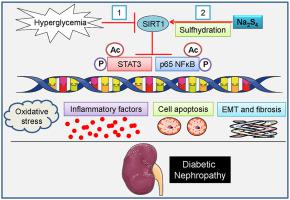Redox Biology ( IF 10.7 ) Pub Date : 2020-11-25 , DOI: 10.1016/j.redox.2020.101813 Hai-Jian Sun 1 , Si-Ping Xiong 1 , Xu Cao 1 , Lei Cao 1 , Meng-Yuan Zhu 1 , Zhi-Yuan Wu 1 , Jin-Song Bian 2

|
Diabetic kidney disease is known as a major cause of chronic kidney disease and end stage renal disease. Polysulfides, a class of chemical agents with a chain of sulfur atoms, are found to confer renal protective effects in acute kidney injury. However, whether a polysulfide donor, sodium tetrasulfide (Na2S4), confers protective effects against diabetic nephropathy remains unclear. Our results showed that Na2S4 treatment ameliorated renal dysfunctional and histological damage in diabetic kidneys through inhibiting the overproduction of inflammation cytokine and reactive oxygen species (ROS), as well as attenuating renal fibrosis and renal cell apoptosis. Additionally, the upregulated phosphorylation and acetylation levels of p65 nuclear factor κB (p65 NF-κB) and signal transducer and activator of transcription 3 (STAT3) in diabetic nephropathy were abrogated by Na2S4 in a sirtuin-1 (SIRT1)-dependent manner. In renal tubular epithelial cells, Na2S4 directly sulfhydrated SIRT1 at two conserved CXXC domains (Cys371/374; Cys395/398), then induced dephosphorylation and deacetylation of its targeted proteins including p65 NF-κB and STAT3, thereby reducing high glucose (HG)-caused oxidative stress, cell apoptosis, inflammation response and epithelial-to-mesenchymal transition (EMT) progression. Most importantly, inactivation of SIRT1 by a specific inhibitor EX-527, small interfering RNA (siRNA), a de-sulfhydration reagent dithiothreitol (DTT), or mutation of Cys371/374 and Cys395/398 sites at SIRT1 abolished the protective effects of Na2S4 on diabetic kidney insulting. These results reveal that polysulfides may attenuate diabetic renal lesions via inactivation of p65 NF-κB and STAT3 phosphorylation/acetylation through sulfhydrating SIRT1.
中文翻译:

多硫化物介导的 SIRT1 硫化通过抑制 p65 NF-κB 和 STAT3 的磷酸化和乙酰化来预防糖尿病肾病
糖尿病肾病被称为慢性肾病和终末期肾病的主要原因。多硫化物是一类具有硫原子链的化学试剂,被发现在急性肾损伤中具有肾脏保护作用。然而,多硫化物供体四硫化钠 (Na 2 S 4 ) 是否对糖尿病肾病具有保护作用仍不清楚。我们的结果表明,Na 2 S 4治疗通过抑制炎症细胞因子和活性氧(ROS)的过度产生,以及减轻肾纤维化和肾细胞凋亡来改善糖尿病肾脏的肾功能障碍和组织学损伤。此外,糖尿病肾病中 p65 核因子 κB (p65 NF-κB) 和信号转导和转录激活因子 3 (STAT3) 上调的磷酸化和乙酰化水平被sirtuin-1 (SIRT1) 依赖中的 Na 2 S 4消除方式。在肾小管上皮细胞中,Na 2 S 4直接在两个保守的 CXXC 结构域(Cys371/374;Cys395/398)上硫化 SIRT1,然后诱导其靶蛋白(包括 p65 NF-κB 和 STAT3)的去磷酸化和去乙酰化,从而减少高葡萄糖 (HG) 引起的氧化应激、细胞凋亡、炎症反应和上皮间质转化(EMT)进展。最重要的是,通过特异性抑制剂 EX-527、小干扰 RNA (siRNA)、脱硫试剂二硫苏糖醇 (DTT) 或 SIRT1 上 Cys371/374 和 Cys395/398 位点的突变使 SIRT1 失活,消除了 Na 的保护作用。2小4关于糖尿病肾损伤。这些结果表明,多硫化物可通过硫化 SIRT1 使 p65 NF-κB 失活和 STAT3 磷酸化/乙酰化减轻糖尿病肾损伤。











































 京公网安备 11010802027423号
京公网安备 11010802027423号